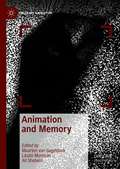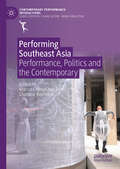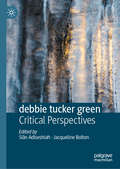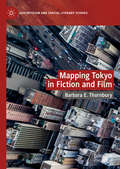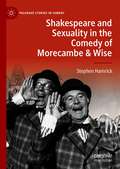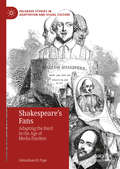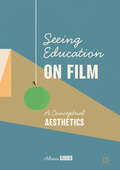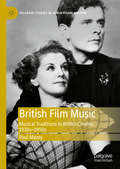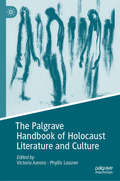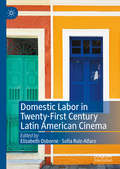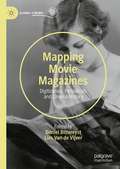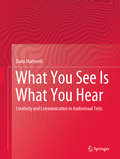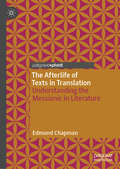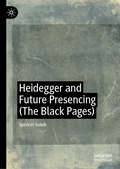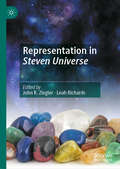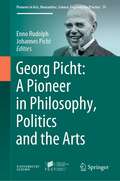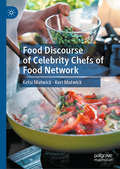- Table View
- List View
Animation and Memory (Palgrave Animation)
by László Munteán Maarten Van Gageldonk Ali ShobeiriThis book examines the role of memory in animation, as well as the ways in which the medium of animation can function as a technology of remembering and forgetting. By doing so, it establishes a platform for the cross-fertilization between the burgeoning fields of animation studies and memory studies. By analyzing a wide range of different animation types, from stop motion to computer animation, and from cell animated cartoons to painted animation, this book explores the ways in which animation can function as a representational medium. The five parts of the book discuss the interrelation of animation and memory through the lens of materiality, corporeality, animation techniques, the city, and animated documentaries. These discussions raise a number of questions: how do animation films bring forth personal and collective pasts? What is the role of found footage, objects, and sound in the material and affective dimensions of animation? How does animation serve political ends? The essays in this volume offer answers to these questions through a wide variety of case studies and contexts. The book will appeal to both a broad academic and a more general readership with an interest in animation studies, memory studies, cultural studies, comparative visual arts, and media studies.
Performing Southeast Asia: Performance, Politics and the Contemporary (Contemporary Performance InterActions)
by Marcus Cheng Chye Tan Charlene RajendranPerforming Southeast Asia: Performance, Politics and the Contemporary is an important reconsideration of the histories and practices of theatre and performance in a fluid and dynamic region that is also experiencing an overarching politics of complexity, precarity and populist authoritarian tendencies. In a substantial introductory essay and essays by leading scholars, activists and practitioners working inside the region, the book explores fundamental questions for the arts. The book asks how theatre contributes to and/or addresses the political condition in the contemporary moment, how does it represent the complexity of experiences in peoples’ daily lives and how does theatre engage in forms of political activism and enable a diversity of voices to flourish. The book shows how, in an age of increasingly violent politics, political institutions become sites for bad actors and propaganda. Forces of biopolitics, neo-liberalism and religious and ethnic nationalism intersect in unpredictable ways with decolonial practices – all of which the book argues are forces that define the contemporary moment. Indeed, by putting the focus on contemporary politics in the region alongside the diversity of practices in contemporary theatre, we see a substantial reformation of the idea of the contemporary moment, not as a cosmopolitan and elite artistic practice but as a multivalent agent of change in both aesthetic and political terms. With its focus on community activism and the creative possibilities of the performing arts the region, Performing Southeast Asia, is a timely intervention that brings us to a new understanding of how contemporary Southeast Asia has become a site of contest, struggle and reinvention of the relations between the arts and society. Peter Eckersall The Graduate Center City University of New York Performing Southeast Asia – with chapters concerned with how regional theatres seek contextually-grounded, yet post-national(istic) forms; how history and tradition shape but do not hold down contemporary theatre; and how, in the editors’ words, such artistic encounters could result in theatres ‘that do not merely attend to matters of cultural heritage, tradition or history, but instead engage overtly with theatre and performance in the contemporary’ – contributes to the possibility of understanding what options for an artistically transubstantiated now-ness may be: to the possibility, that is, of what might be called a ‘Present-Tense Theatre’. C. J. W.-L. Wee Professor of English Nanyang Technological University Performing Southeast Asia examines contemporary performance practices and their relationship with politics and governance in Southeast Asia in the twenty-first century. In a region haunted historically by strongman politics, authoritarianism and militarism, religious tension and ethnic strife, the chapters reveal how contemporary theatre and performances in the present reflect yet challenge dominant socio-political discourses. The authors analyse works of political commitment and conviction, created and performed by Southeast Asian artists, as modes and platforms of reaction and resistance to the shifting political climates that inform contemporary life in urban Southeast Asia. The discussions center on issues of state hegemonies and biopolitics, finance and sponsorship, social liberalism and conservatism, the relevance of history and tradition, and globalisation and cultural practice. These diverse yet related concerns converge on an examination of the efficacies of theatre and performance as means of political intervention and transformation that point to alternative embodiments of political consciousness through which artists propose critical options for rethinking the state, citizenship, identity and belonging in a time of seismic socio-political change. The editors also reframe an understanding of ‘the c
debbie tucker green: Critical Perspectives
by Siân Adiseshiah Jacqueline BoltonThis long-awaited book is the first full-length study of the work of the extraordinary contemporary black British playwright, debbie tucker green. Covering the period from 2000 (Two Women) to 2017 (a profoundly affectionate, passionate devotion to someone (-noun)), it offers scholars and students the opportunity to engage in cutting-edge critical debate engendered by tucker green’s innovative dramatic works for stage, television, and radio. This groundbreaking book includes contributions by a range of outstanding scholars, including black playwriting specialists, world-leading contemporary theatre scholars and some of the very best emerging researchers in the field. While always focused on the precision and detail of tucker green’s work, this book simultaneously reframes broader debates around contemporary drama and its politics, poses new questions of theatre, and provokes scholarly thinking in ways that, however obliquely, contribute to the change for which the plays agitate.
Mapping Tokyo in Fiction and Film (Geocriticism and Spatial Literary Studies)
by Barbara E. ThornburyMapping Tokyo in Fiction and Film explores ways that late 20th- and early 21st- century fiction and film from Japan literally and figuratively map Tokyo. The four dozen novels, stories, and films discussed here describe, define, and reflect on Tokyo urban space. They are part of the flow of Japanese-language texts being translated (or, in the case of film, subtitled) into English. Circulation in professionally translated and subtitled English-language versions helps ensure accessibility to the primarily anglophone readers of this study—and helps validate inclusion in lists of world literature and film. Tokyo’s well-established culture of mapping signifies much more than a profound attachment to place or an affinity for maps as artifacts. It is, importantly, a counter-response to feelings of insecurity and disconnection—insofar as the mapping process helps impart a sense of predictability, stability, and placeness in the real and imagined city.
Shakespeare and Sexuality in the Comedy of Morecambe & Wise (Palgrave Studies in Comedy)
by Stephen HamrickContextualizing the duo’s work within British comedy, Shakespeare criticism, the history of sexuality, and their own historical moment, this book offers the first sustained analysis of the 20th Century’s most successful double-act. Over the course of a forty-four-year career (1940-1984), Eric Morecambe & Ernie Wise appropriated snippets of verse, scenes, and other elements from seventeen of Shakespeare’s plays more than one-hundred-and-fifty times. Fashioning a kinder, more inclusive world, they deployed a vast array of elements connected to Shakespeare, his life, and institutions. Rejecting claims that they offer only nostalgic escapism, Hamrick analyses their work within contemporary contexts, including their engagement with many forms and genres, including Variety, the heritage industry, journalism, and more. ‘The Boys’ deploy Shakespeare to work through issues of class, sexuality, and violence. Lesbianism, drag, gay marriage, and a queer aesthetics emerge, helping to normalize homosexuality and complicate masculinity in the ‘permissive’ 1960s.
Shakespeare’s Fans: Adapting the Bard in the Age of Media Fandom (Palgrave Studies in Adaptation and Visual Culture)
by Johnathan H. PopeThis book examines Shakespearean adaptations through the critical lens of fan studies and asks what it means to be a fan of Shakespeare in the context of contemporary media fandom. Although Shakespeare studies and fan studies have remained largely separate from one another for the past thirty years, this book establishes a sustained dialogue between the two fields. In the process, it reveals and seeks to overcome the problematic assumptions about the history of fan cultures, Shakespeare’s place in that history, and how fan works are defined. While fandom is normally perceived as a recent phenomenon focused primarily on science fiction and fantasy, this book traces fans’ practices back to the eighteenth century, particularly David Garrick’s Shakespeare Jubilee in 1769. Shakespeare’s Fans connects historical and scholarly debates over who owns Shakespeare and what constitutes an appropriate adaptation of his work to online fan fiction and commercially available fan works.
Seeing Education on Film: A Conceptual Aesthetics
by Alexis GibbsThis book argues that certain films have more to offer by way of conceptualising education than textual scholarship. Drawing on the work of the later Wittgenstein, it suggests that a shift in our philosophical focus from knowing to seeing can allow for ordinary educational phenomena (teachers, schools, children) to be appreciated anew. The book argues that cinema is the medium best placed to draw attention to this revaluation of the everyday, and particular films are presented as offering unique insights into the aesthetic nature of education as a concept. The book will be of primary interest to educators and educationalists alike, but its interdisciplinary nature should also appeal to those in the fields of film study, philosophy, and aesthetics.
British Film Music: Musical Traditions in British Cinema, 1930s–1950s (Palgrave Studies in Audio-Visual Culture)
by Paul MazeyThis book offers a fresh approach to British film music by tracing the influence of Britain’s musical heritage on the film scores of this era. From the celebration of landscape and community encompassed by pastoral music and folk song, and the connection of both with the English Musical Renaissance, to the mystical strains of choral sonorities and the stirring effects of the march, this study explores the significance of music in British film culture. With detailed analyses of the work of such key filmmakers as Michael Powell and Emeric Pressburger, Laurence Olivier and Carol Reed, and composers including Ralph Vaughan Williams, William Walton and Brian Easdale, this systematic and in-depth study explores the connotations these musical styles impart to the films and considers how each marks them with a particularly British inflection.
European Cinema in the Twenty-First Century: Discourses, Directions and Genres
by Ingrid Lewis Laura CanningThis book rethinks the study of European Cinema in a way that centres on students and their needs, in a comprehensive volume introducing undergraduates to the main discourses, directions and genres of twenty-first-century European film. Importantly, this collection is the first of its kind to apply a transversal approach to European Cinema, bringing together the East and the West, while providing a broad picture of key trends, aesthetics, genres, national identities, and transnational concerns. Lewis and Canning’s collection effectively addresses some of the most pressing questions in contemporary European film, such as ecology, migration, industry, identity, disability, memory, auteurship, genre, small cinemas, and the national and international frameworks which underpin them. Combining accessible original research with a thorough grounding in recent histories and contexts, each chapter includes key definitions, reflective group questions, and a summative case study. Overall, this book makes a strong contribution to our understanding of recent European Cinema, making it an invaluable resource for lecturers and students across a variety of film-centred modules.
The Palgrave Handbook of Holocaust Literature and Culture
by Victoria Aarons Phyllis LassnerThe Palgrave Handbook of Holocaust Literature and Culture reflects current approaches to Holocaust literature that open up future thinking on Holocaust representation. The chapters consider diverse generational perspectives—survivor writing, second and third generation—and genres—memoirs, poetry, novels, graphic narratives, films, video-testimonies, and other forms of literary and cultural expression. In turn, these perspectives create interactions among generations, genres, temporalities, and cultural contexts. The volume also participates in the ongoing project of responding to and talking through moments of rupture and incompletion that represent an opportunity to contribute to the making of meaning through the continuation of narratives of the past. As such, the chapters in this volume pose options for reading Holocaust texts, offering openings for further discussion and exploration. The inquiring body of interpretive scholarship responding to the Shoah becomes itself a story, a narrative that materially extends our inquiry into that history.
Domestic Labor in Twenty-First Century Latin American Cinema
by Elizabeth Osborne Sofía Ruiz-AlfaroThis volume explores the character of the domestic worker in twenty-first century Latin American cinema and analyzes how recent filmic representations of the housemaid question the marginalization of domestic servants, in particular women, by making them the center of their narratives, their families, and society. The essays in this book posit the female domestic worker as an emergent subjectivity, a complex character who problematizes and contests the hierarchical power structures within the family dynamics and new socioeconomic orders found in contemporary Latin America. Readers will find a variety of representations across the continent as well as transnational commonalities of the cinematic figure and role of the housemaid, including the negotiation of a multilayered politics of affection in the framework of prevalent paternalism, and the complex and contradictory dynamic between private and public spaces, where domestic paid labor occupies a central role in maintaining gender, class, and ethnic inequalities.
Mapping Movie Magazines: Digitization, Periodicals and Cinema History (Global Cinema)
by Daniel Biltereyst Lies Van de VijverMovie magazines are crucial but widely underused sources for writing the history of films and cinema. This volume brings together for the first time a wide variety of historic research of movie magazines and film trade journals, reflecting on the issue of using these sources for film/cinema historiography and on the impact of digitization processes. Mapping Movie Magazines explores this debate from different disciplinary perspectives, enlightened by case studies from the use of early film trade press to pedagogical uses of digitized periodicals. The volume explores Hollywood’s grip on movie magazines, gender in film journalism, typologies of unknown trade press and movie magazine markets, and subversive Tijuana bibles.
Screening Scarlett Johansson: Gender, Genre, Stardom
by Janice Loreck Whitney Monaghan Kirsten StevensScreening Scarlett Johansson: Gender, Genre, Stardom provides an account of Johansson’s persona, work and stardom, extending from her breakout roles in independent cinema, to contemporary blockbusters, to her self-parodying work in science-fiction. Screening Scarlett Johansson is more than an account of Johansson’s career; it positions Johansson as a point of reference for interrogating how femininity, sexuality, identity and genre play out through a contemporary woman star and the textual manipulations of her image. The chapters in this collection cast a critical eye over the characters Johansson has portrayed, the personas she has inhabited, and how the two intersect and influence one another. They draw out the multitude of meanings generated through and inherent to her performances, specifically looking at processes of transformation, metamorphosis and self-deconstruction depicted in her work.
The Films of Kore-eda Hirokazu: An Elemental Cinema (East Asian Popular Culture)
by Linda C. EhrlichThe Films of Kore-eda Hirokazu: An Elemental Cinema draws readers into the first 13 feature films and 5 of the documentaries of award-winning Japanese film director Kore-eda Hirokazu. With his recent top prize at the Cannes Film Festival for Shoplifters, Kore-eda is arguably Japan’s greatest living director with an international viewership. He approaches difficult subjects (child abandonment, suicide, marginality) with a realistic and compassionate eye.The lyrical tone of the writing of Japanese film scholar Linda C. Ehrlich perfectly complements the understated, yet powerful, tone of the films. From An Elemental Cinema, readers will gain a special understanding of Kore-eda’s films through a novel connection to the natural elements as reflected in Japanese traditional aesthetics.An Elemental Cinema presents Kore-eda’s oeuvre as a connected whole with overarching thematic concerns, despite frequent generic experimentation. It also offers an example of how the poetics of cinema can be practiced in writing, as well as on the screen, and helps readers understand the films of this contemporary director as works of art that relate to their own lives.
What You See Is What You Hear: Creativity and Communication in Audiovisual Texts
by Dario MartinelliWhat You See Is What You Hear develops a unique model of analysis that helps students and advanced scholars alike to look at audiovisual texts from a fresh perspective. Adopting an engaging writing style, the author draws an accessible picture of the field, offering several analytical tools, historical background, and numerous case studies. Divided into five main sections, the monograph covers problems of definitions, history, and most of all analysis. The first part raises the main problems related to audiovisuality, including taxonomical and historical questions. The second part provides the bases for the understanding of audiovisual creative communication as a whole, introducing a novel theoretical model for its analysis. The next three part focus elaborate on the model in all its constituents and with plenty of case studies taken from the field of cinema, TV, music videos, advertising and other forms of audiovisuality. Methodologically, the book is informed by different paradigms of film and media studies, multimodality studies, structuralism, narratology, “auteur theory” in the broad sense, communication studies, semiotics, and the so-called “Numanities.” What You See Is What You Hear enables readers to better understand how to analyze the structure and content of diverse audiovisual texts, to discuss their different idioms, and to approach them with curiosity and critical spirit.
The Geo-Doc: Geomedia, Documentary Film, and Social Change (Palgrave Studies in Media and Environmental Communication)
by Mark TerryThis book introduces a new form of documentary film: the Geo-Doc, designed to maximize the influential power of the documentary film as an agent of social change. By combining the proven methods and approaches as evidenced through historical, theoretical, digital, and ecocritical investigations with the unique affordances of Geographic Information System technology, a dynamic new documentary form emerges, one tested in the field with the United Nations. This book begins with an overview of the history of the documentary film with attention given to how it evolved as an instrument of social change. It examines theories surrounding mobilizing the documentary film as a communication tool between filmmakers and policymakers. Ecocinema and its semiotic storytelling techniques are also explored for their unique approaches in audience engagement. The proven methods identified throughout the book are combined with the spatial and temporal affordances provided by GIS technology to create the Geo-Doc, a new tool for the activist documentarian.
The Afterlife of Texts in Translation: Understanding the Messianic in Literature
by Edmund ChapmanThe Afterlife of Texts in Translation: Understanding the Messianic in Literature reads Walter Benjamin’s and Jacques Derrida’s writings on translation as suggesting that texts exist within a process of continual translation. Understanding Benjamin’s and Derrida’s concept of ‘afterlife’ as ‘overliving’, this book proposes that reading Benjamin’s and Derrida’s writings on translation in terms of their wider thought on language and history suggests that textuality itself possesses a ‘messianic’ quality. Developing this idea in relation to the many rewritings and translations of Don Quijote, particularly the multiple rewritings by Jorge Luis Borges, Edmund Chapman asserts that texts consist of a structure of potential for endless translation that continually promises the overcoming of language, history and textuality itself.
Dance on the Historically Black College Campus: The Familiar and the Foreign (The Arts in Higher Education)
by Wanda K. EbrightThis volume explores the history of dance on the historically black college and university (HBCU) campus, casting a first light on the historical practices and current state of college dance program practice in HBCUs. The author addresses how HBCU dance programs developed their institutional visions and missions in a manner that offers students an experience of American higher education in dance, while honoring how the African diaspora persists in and through these experiences. Chapters illustrate how both Western and African diaspora dances have persisted, integrated through curriculum and practice, and present a model for culturally inclusive histories, traditions, and practices that reflect Western and African diasporas in ongoing dialogue and negotiation on the HBCU campus today.
Heidegger and Future Presencing (The Black Pages)
by Spencer GolubThis book applies Heidegger’s writings to experimental fictions and film genres in order to study a being-there that performs itself beyond liveness and a future that is already here. Theatrical mise-en-scène is analyzed as a way of modeling the Heideggerian ontological-existential, exchanging a deeper presencing for the fictional “now” of liveness. The book is organized around ostensible objects that are in fact things-as-such and performs its theme via time-traveling, interruptions, decompositions, incompleteness, failure, geometric patterning, and above all black pages first cited in Tristram Shandy. This is a nuanced, original work that combines unexpected sources with even more unexpected writing, imagery, and correspondences. It is part of Golub’s ongoing project of lyrically reimagining philosophy and the mise-en-scène of theatrical performance (a presence-room of consciousness) in light of one another.
Representation in Steven Universe
by John R. Ziegler Leah RichardsThis book assembles ten scholarly examinations of the politics of representation in the groundbreaking animated children’s television series Steven Universe. These analyses address a range of representational sites and subjects, including queerness, race, fandom, colonialism, and the environment, and provide an accessible foundation for further scholarship. The introduction contextualizes Steven Universe in the children’s science-fiction and anime traditions and discusses the series’ crucial mechanic of fusion. Subsequent chapters probe the fandom’s expressions of queer identity, approach the series’ queer force through the political potential of the animated body, consider the unequal privilege of different female characters, and trace the influence of anime director Kunihiko Ikuhara. Further chapters argue that Ronaldo allows satire of multiple media forms, focus on Onion as a surrealist trickster, and contemplate cross-species hybridity and consent. The final chapters concentrate on background art in connection with ecological and geological narratives, adopt a decolonial perspective on the Gems’ legacy, and interrogate how the tension between personal and cultural narratives constantly recreates memory.
Georg Picht: A Pioneer in Philosophy, Politics and the Arts (Pioneers in Arts, Humanities, Science, Engineering, Practice #19)
by Enno Rudolph Johannes PichtAimed at an international readership, this book offers a representative collection of essays by the German philosopher, Georg Picht (1913-1982), who was a specialist in Greek philosophy, practical philosophy and philosophy of religion. Picht's themes address different disciplines, such as ancient philosophy, systematic philosophy and political analysis, and often contain critical statements on significant developments from the European Enlightenment to the Cold War era. Other essays offer a distinctive interdisciplinary approach characteristic of the author. These contributions are relevant to both philosophy and science as they discuss, for instance, philosophical definitions of space and time or the relationship between history and evolution. Another part of the book includes texts on art that present Picht’s authentic definition of art and his theory of the interdependence of art and politics.• For the first time, key texts of the German philosopher and political thinker Georg Picht are presented to a global readership in English.• Like Nietzsche’s philosophy, Picht’s work is grounded in his outstanding professionalism in the different fields of classics, embracing not only textsand theories of the great thinkers from the pre-Socratic to the post-Aristotelian and Stoic philosophies but also the main currents of ancient literature.• Picht’s importance as a political author and public adviser is exceptional, and may explain why his lifelong friend Carl Friedrich von Weizsäcker – another pioneer presented in this series – called him his “teacher”.
Consuming Cultural Hegemony: Bollywood in Bangladesh
by Harisur RahmanThis book examines the circulation and viewership of Bollywood films and filmi modernity in Bangladesh. The writer poses a number of fundamental questions: what it means to be a Bangladeshi in South Asia, what it means to be a Bangladeshi fan of Hindi film, and how popular film reflects power relations in South Asia. The writer argues that partition has resulted in India holding hegemonic power over all of South Asia’s nation-states at the political, economic, and military levels–a situation that has made possible its cultural hegemony. The book draws on relevant literature from anthropology, sociology, film, media, communication, and cultural studies to explore the concepts of hegemony, circulation, viewership, cultural taste, and South Asian cultural history and politics.
Endings in the Cinema: Thresholds, Water and the Beach
by Michael WalkerThis book offers a new way of thinking about film endings. Whereas existing works on the subject concentrate on narrative resolution, this book explores the way film endings blend together a complex of motifs, tropes and other elements to create the sense of an ending—that is, it looks at ‘endings as endings’. Drawing on a wide range of examples taken from films of different periods and national cinemas, the author identifies three key features which structure the work: thresholds and boundaries, water, and, above all, the beach. The beach combines water and a boundary and is the most resonant of the key sites to which film endings gravitate. Although beach endings go back to at least 1910, they have increased markedly in post-classical cinema, and can be found across all genres and in films from many different countries. As the leading example of the book’s argument, they illustrate both the aesthetic richness and the structural complexity of film endings.
Final Girls, Feminism and Popular Culture
by Katarzyna Paszkiewicz Stacy RusnakThis volume examines contemporary reformulations of the ‘Final Girl’ in film, TV, literature and comic, expanding the discussion of the trope beyond the slasher subgenre. Focusing specifically on popular texts that emerged in the 21st century, the volume asks: What is the sociocultural context that facilitated the remarkable proliferation of the Final Girls? What kinds of stories are told in these narratives and can they help us make sense of feminism? What are the roles of literature and media in the reconsiderations of Carol J. Clover’s term of thirty years ago and how does this term continue to inform our understanding of popular culture? The contributors to this collection take up these concerns from diverse perspectives and with different answers, notably spanning theories of genre, posthumanism, gender, sexuality and race, as well as audience reception and spectatorship.
Food Discourse of Celebrity Chefs of Food Network
by Kelsi Matwick Keri MatwickFood Discourse explores a fascinating, yet virtually unexplored research area: the language of food used on television cooking shows. It shows how the discourse of television cooking shows on the American television channel Food Network conveys a pseudo-relationship between the celebrity chef host and viewers. Excerpts are drawn from a variety of cooking show genres (how-to, travel, reality, talk, competition), providing the data for this qualitative investigation. Richly interdisciplinary, the study draws upon discourse analysis, narrative, social semiotics, and media communication in order to analyze four key linguistic features – recipe telling, storytelling, evaluations, and humor – in connection with the themes of performance, authenticity, and expertise, essential components in the making of celebrity chefs. Given its scope, the book will be of interest to scholars of linguistics, media communication, and American popular culture. Further, in light of the international reach and influence of American television and celebrity chefs, it has a global appeal.
